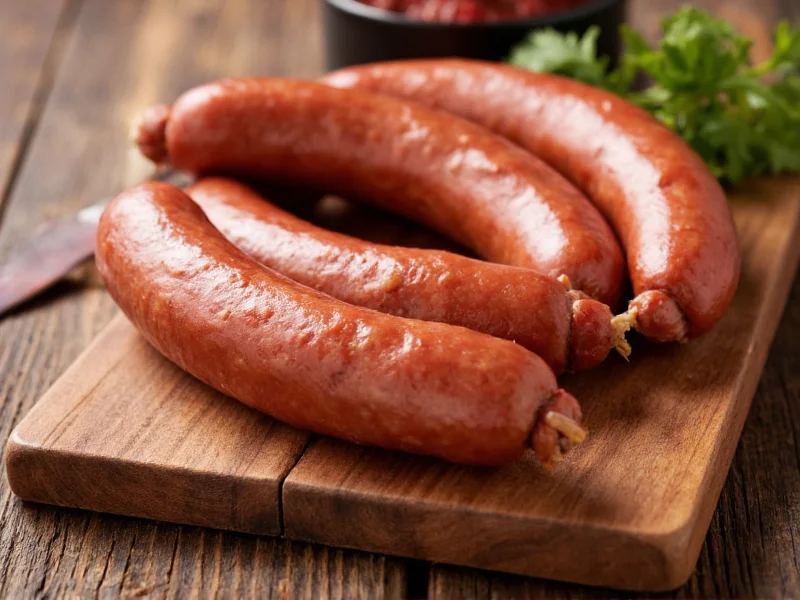Understanding smoked sausage begins with recognizing its dual nature as both a preserved food product and versatile culinary ingredient. This fully cooked meat product has been a staple in kitchens worldwide for centuries, valued for its extended shelf life and rich, complex flavor profile developed through the smoking process. Whether you're preparing traditional Southern dishes, hearty European recipes, or modern fusion cuisine, smoked sausage offers consistent quality and distinctive taste that few other ingredients can match.
The Science Behind Smoking Sausage
The smoking process serves multiple critical functions beyond flavor development. When meat is exposed to smoke, phenolic compounds and other antimicrobial agents penetrate the surface, creating an environment hostile to bacteria growth. This natural preservation method, combined with curing salts containing sodium nitrite, extends shelf life while maintaining food safety. The temperature during smoking determines whether the sausage becomes fully cooked (hot smoking) or merely preserved (cold smoking).
Types of Smoked Sausage You Should Know
Smoked sausages vary significantly by region, ingredients, and preparation methods. Understanding these differences helps you select the right variety for your culinary needs:
| Type | Origin | Key Characteristics | Best Culinary Uses |
|---|---|---|---|
| Andouille | France/Louisiana | Coarsely ground, heavily spiced with pepper | Gumbo, jambalaya, red beans and rice |
| Kielbasa | Poland | Garlic-forward, U-shaped curve | Grilling, soups, with sauerkraut |
| Ring Bologna | Germany/US Midwest | Finely ground, mild flavor | Sandwiches, fried as breakfast meat |
| Chorizo | Spain/Mexico | Spicy, paprika-infused (Spanish) or fresher (Mexican) | Tapas, scrambled eggs, bean dishes |
| Smoked Bratwurst | Germany | Herbaceous, coarsely textured | Grilling, beer-based braises |
Smoked Sausage vs. Fresh Sausage: Critical Differences
Many home cooks confuse smoked sausage with fresh sausage, but understanding the distinction prevents culinary mistakes. Smoked sausage has already undergone cooking through the smoking process, making it safe to eat straight from packaging. Fresh sausage requires thorough cooking to 160°F internal temperature before consumption.
When cooking with smoked sausage, remember it primarily needs heating rather than cooking. This distinction affects preparation time and technique. Overcooking smoked sausage causes fat rendering and texture deterioration, resulting in dry, crumbly meat. For best results when how to cook smoked sausage for dishes like gumbo or jambalaya, add it during the final 15-20 minutes of cooking to preserve texture and prevent excessive salt concentration.
Proper Storage and Shelf Life Guidelines
Understanding how long does smoked sausage last is crucial for food safety. Unopened smoked sausage maintains quality for 2-3 weeks in the refrigerator (below 40°F) and up to 2 months frozen. Once opened, consume within 7 days refrigerated. Always check for these spoilage indicators:
- Grayish discoloration or green spots
- Slippery or sticky surface texture
- Sour or ammonia-like odor
- Unpleasantly soft or mushy consistency
When freezing smoked sausage for extended storage, wrap portions tightly in freezer paper or vacuum seal to prevent freezer burn. Thaw frozen sausage in the refrigerator overnight rather than at room temperature to maintain food safety.
Maximizing Flavor in Your Cooking
Professional chefs leverage smoked sausage's flavor complexity through strategic pairing. The rich, smoky notes complement ingredients that provide contrast:
- Acidic elements like tomatoes, vinegar, or citrus cut through richness
- Sweet components such as caramelized onions or bell peppers balance saltiness
- Starchy bases including rice, beans, or potatoes absorb and distribute flavor
For authentic best smoked sausage for gumbo, choose Andouille with coarse texture that holds up during long simmers. When making breakfast dishes, milder varieties like Ring Bologna allow other flavors to shine. Always slice against the grain for optimal texture, and consider partially freezing sausage for cleaner cuts.
Nutritional Profile and Dietary Considerations
While flavorful, smoked sausage contains significant sodium (approximately 500-700mg per 3-ounce serving) and saturated fat. Modern producers offer reduced-sodium and turkey-based alternatives for health-conscious consumers. The smoking process itself doesn't significantly alter nutritional content but does create trace compounds like polycyclic aromatic hydrocarbons (PAHs), which occur naturally in all smoked foods at safe levels when properly prepared.
When incorporating smoked sausage into balanced meals, pair with abundant vegetables and whole grains to offset sodium content. For those monitoring sodium intake, rinsing sliced sausage under cold water before cooking can reduce surface salt by up to 30%.
Frequently Asked Questions
Is smoked sausage already cooked and safe to eat without preparation?
Yes, commercially produced smoked sausage undergoes full cooking during the smoking process (typically to 165°F internal temperature) and is safe to eat straight from the package. However, heating enhances texture and flavor, and many culinary applications require incorporation into hot dishes.
How long does smoked sausage last in the refrigerator after opening?
Properly stored in an airtight container at or below 40°F, opened smoked sausage remains safe to eat for 5-7 days. Always check for spoilage signs like sour odor, slimy texture, or discoloration before consumption, regardless of timeframe.
What's the best way to reheat smoked sausage without drying it out?
Simmer sliced sausage in liquid (broth, beer, or water) for 8-10 minutes rather than direct high-heat methods. This gentle reheating preserves moisture while enhancing flavor. Avoid prolonged high-temperature cooking which causes fat rendering and texture deterioration.
Can you freeze smoked sausage, and how does it affect quality?
Yes, smoked sausage freezes well for up to 2 months when properly wrapped in freezer paper or vacuum sealed. Freezing slightly alters texture but preserves flavor. Thaw in the refrigerator overnight for best results—never at room temperature—to maintain food safety.
What distinguishes smoked sausage from kielbasa or andouille?
Smoked sausage is a broad category, while kielbasa (Polish) and andouille (French/Louisiana) are specific regional varieties. Kielbasa features prominent garlic flavor, while authentic andouille uses coarsely ground meat and heavy pepper seasoning. Both are types of smoked sausage with distinctive preparation methods and flavor profiles.











 浙公网安备
33010002000092号
浙公网安备
33010002000092号 浙B2-20120091-4
浙B2-20120091-4